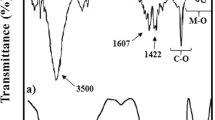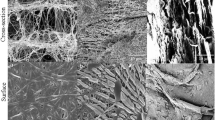Abstract
As-produced bacterial cellulose (BC) hydrogel has been dried by two methods [oven drying (OD) and freeze drying (FD)] to obtain two different release profiles of the drug diclofenac sodium (DCF). Freeze dried BC exhibits a immediate first order release, while the oven dried BC shows a sustained non-Fickian supercase II transport/release of drug. The difference in the release profiles is due to the difference in the fiber and matrix flexibility, pore size distribution and density. More importantly, this work presents a facile way to obtain a combination of immediate as well as sustained release by a simple assembly of OD and FD BC. It has been shown that the assembled (stacked) sample can offer a burst release for 1 h for immediate pain relief followed by a sustained release for long term pain management. This work can be extended to provide a combinational release of different drugs, where the release profiles need to be different as per their need and activity.





Similar content being viewed by others
References
Abeer MM, Mohd Amin MCI, Martin C (2014) A review of bacterial cellulose-based drug delivery systems: their biochemistry, current approaches and future prospects. J Pharm Pharmacol 66:1047–1061
Adepu S, Khandelwal M (2018) Broad-spectrum antimicrobial activity of bacterial cellulose silver nanocomposites with sustained release. J Mater Sci 53:1596–1609
Adepu S, Khandelwal M (2020a) Bacterial cellulose with microencapsulated antifungal essential oils: a novel double barrier release system. Materialia 2020:100585
Adepu S, Khandelwal M (2020b) Ex-situ modification of bacterial cellulose for immediate and sustained drug release with insights into release mechanism. CarbohydPolym 249:116816
Adepu S, Gaydhane MK, Kakunuri M, Sharma CS, Khandelwal M, Eichhorn SJ (2017) Effect of micropatterning induced surface hydrophobicity on drug release from electrospun cellulose acetate nanofibers. Appl Surf Sci 426:755–762
Cacicedo ML, León IE, Gonzalez JS, Porto LM, Alvarez VA, Castro GR (2016) Modified bacterial cellulose scaffolds for localized doxorubicin release in human colorectal HT-29 cells. Colloids Surf B 140:421–429
Cipolla DC, Blanchard J (2012) Dual action, inhaled formulations providing both an immediate and sustained release profile. Google Patents
de Lima FM, Meneguin AB, Tercjak A, Gutierrez J, Cury BSF, dos Santos AM et al (2018) Effect of in situ modification of bacterial cellulose with carboxymethylcellulose on its nano/microstructure and methotrexate release properties. CarbohydPolym 179:126–134
Durairaj C, Kim SJ, Edelhauser HF, Shah JC, Kompella UB (2009) Influence of dosage form on the intravitreal pharmacokinetics of diclofenac. Invest Ophthalmol Vis Sci 50:4887–4897
Fuller ME, Andaya C, McClay K (2018) Evaluation of ATR-FTIR for analysis of bacterial cellulose impurities. J Microbiol Methods 144:145–151
Gatenholm P, Klemm D (2010) Bacterial nanocellulose as a renewable material for biomedical applications. MRS Bull 35:208–213
Hu X, Liu S, Zhou G, Huang Y, Xie Z, Jing X (2014) Electrospinning of polymeric nanofibers for drug delivery applications. J Control Release 185:12–21
Illa MP, Sharma CS, Khandelwal M (2019) Tuning the physiochemical properties of bacterial cellulose: effect of drying conditions. J Mater Sci 2019:1–12
Maver T, Hribernik S, Mohan T, Smrke DM, Maver U, Stana-Kleinschek K (2015) Functional wound dressing materials with highly tunable drug release properties. RSCAdv 5:77873–77884
Mohd Amin MCI, Ahmad N, Pandey M, Jue XC (2014) Stimuli-responsive bacterial cellulose-g-poly (acrylic acid-co-acrylamide) hydrogels for oral controlled release drug delivery. Drug Dev Ind Pharm 40:1340–1349
Pavaloiu R-D, Stoica A, Stroescu M, Dobre T (2014a) Controlled release of amoxicillin from bacterial cellulose membranes. Open Chem 12:962–967
Pavaloiu R-D, Stoica-Guzun A, Stroescu M, Jinga SI, Dobre T (2014b) Composite films of poly (vinyl alcohol)-chitosan-bacterial cellulose for drug controlled release. Int J Biol Macromol 68:117–124
Pawar H, Tetteh J, Boateng J (2013) Preparation, optimisation and characterisation of novel wound healing film dressings loaded with streptomycin and diclofenac. Colloids Surf B 102:102–110
Pötzinger Y, Kralisch D, Fischer D (2017) Bacterial nanocellulose: the future of controlled drug delivery? TherDeliv 8:753–761
Qi X, Qin X, Yang R, Qin J, Li W, Luan K et al (2016) Intra-articular administration of chitosan thermosensitive in situ hydrogels combined with diclofenac sodium-loaded alginate microspheres. J Pharm Sci 105:122–130
Ritger PL, Peppas NA (1987) A simple equation for description of solute release II. Fickian and anomalous release from swellable devices. J Control Release 5:37–42
Shao W, Liu H, Wang S, Wu J, Huang M, Min H et al (2016) Controlled release and antibacterial activity of tetracycline hydrochloride-loaded bacterial cellulose composite membranes. CarbohydPolym 145:114–120
Silva NH, Rodrigues AF, Almeida IF, Costa PC, Rosado C, Neto CP et al (2014) Bacterial cellulose membranes as transdermal delivery systems for diclofenac: in vitro dissolution and permeation studies. CarbohydPolym 106:264–269
Subtaweesin C, Woraharn W, Taokaew S, Chiaoprakobkij N, Sereemaspun A, Phisalaphong M (2018) Characteristics of curcumin-loaded bacterial cellulose films and anticancer properties against malignant melanoma skin cancer cells. Appl Sci 8:1188
Trovatti E, Freire CS, Pinto PC, Almeida IF, Costa P, Silvestre AJ et al (2012) Bacterial cellulose membranes applied in topical and transdermal delivery of lidocaine hydrochloride and ibuprofen: in vitro diffusion studies. Int J Pharm 435:83–87
Udayakumar T, Suresh A, Ubaidulla U (2013) Formulation and evaluation of Immediate and sustained release bilayered tablet with glibenclamide and metformin hydrochloride. Intern J Res Dev Pharm Life Sci 2:337–343
Author information
Authors and Affiliations
Corresponding author
Additional information
Publisher's Note
Springer Nature remains neutral with regard to jurisdictional claims in published maps and institutional affiliations.
Supplementary Information
Below is the link to the electronic supplementary material.
Rights and permissions
About this article
Cite this article
Adepu, S., Kalyani, P. & Khandelwal, M. Bacterial Cellulose-Based Drug Delivery System for Dual Mode Drug Release. Trans Indian Natl. Acad. Eng. 6, 265–271 (2021). https://doi.org/10.1007/s41403-020-00192-w
Received:
Accepted:
Published:
Issue Date:
DOI: https://doi.org/10.1007/s41403-020-00192-w




